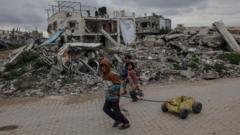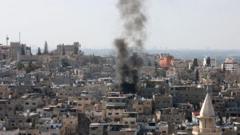As the cease-fire between Israel and Hamas approaches its end, tensions escalate as neither side shows readiness for an extension. This stalemate raises critical questions about the potential consequences for the region and its inhabitants.
Gaza Cease-Fire Stalemate: Implications and Prospects for Peace

Gaza Cease-Fire Stalemate: Implications and Prospects for Peace
With negotiations stalled, the cease-fire between Israel and Hamas faces imminent expiration, raising concerns about future conflict.
The agreement reached in January, intended to halt hostilities for six weeks, now seems fragile. Both parties have engaged in mutual accusations regarding violations of cease-fire terms, particularly concerning the exchange of hostages and prisoners. Recent actions by Israel, such as delaying the release of detainees, have aggravated the situation, with officials citing concerns over the treatment of hostages during their handover.
Only days remain before the current cease-fire concludes, and formal discussions for an extension have yet to commence. U.S. officials, notably the Mideast envoy, plan to re-enter negotiations, nonetheless, the prospects of achieving a long-term resolution seem grim. Key differences remain entrenched, with Israel's stance hinging on the dismantlement of Hamas's military capabilities, while Hamas remains steadfast in rejecting disarmament at this juncture.
This situation leaves millions in Gaza and surrounding regions at risk of renewed conflict, as both sides cling to their preconditions and positions. Analysts emphasize that without significant diplomatic intervention and compromise, the next steps may lead to a re-escalation of violence, further entrenching the cycle of conflict in the region.
Efforts to mediate a longer-term solution appear to be contingent on both parties reconsidering their demands and recognizing the pressing need for stability in a region marred by decades of unrest. As the deadline approaches, the international community watches closely, hopeful for an extension to the fragile peace but increasingly aware of the challenges ahead.
Only days remain before the current cease-fire concludes, and formal discussions for an extension have yet to commence. U.S. officials, notably the Mideast envoy, plan to re-enter negotiations, nonetheless, the prospects of achieving a long-term resolution seem grim. Key differences remain entrenched, with Israel's stance hinging on the dismantlement of Hamas's military capabilities, while Hamas remains steadfast in rejecting disarmament at this juncture.
This situation leaves millions in Gaza and surrounding regions at risk of renewed conflict, as both sides cling to their preconditions and positions. Analysts emphasize that without significant diplomatic intervention and compromise, the next steps may lead to a re-escalation of violence, further entrenching the cycle of conflict in the region.
Efforts to mediate a longer-term solution appear to be contingent on both parties reconsidering their demands and recognizing the pressing need for stability in a region marred by decades of unrest. As the deadline approaches, the international community watches closely, hopeful for an extension to the fragile peace but increasingly aware of the challenges ahead.


















